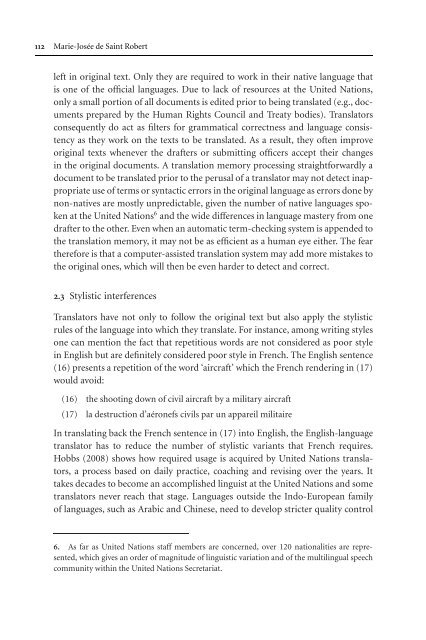Topics in Language Resources for Translation ... - ymerleksi - home
Topics in Language Resources for Translation ... - ymerleksi - home
Topics in Language Resources for Translation ... - ymerleksi - home
- No tags were found...
You also want an ePaper? Increase the reach of your titles
YUMPU automatically turns print PDFs into web optimized ePapers that Google loves.
112 Marie-Josée de Sa<strong>in</strong>t Robertleft <strong>in</strong> orig<strong>in</strong>al text. Only they are required to work <strong>in</strong> their native language thatis one of the official languages. Due to lack of resources at the United Nations,only a small portion of all documents is edited prior to be<strong>in</strong>g translated (e.g., documentsprepared by the Human Rights Council and Treaty bodies). Translatorsconsequently do act as filters <strong>for</strong> grammatical correctness and language consistencyas they work on the texts to be translated. As a result, they often improveorig<strong>in</strong>al texts whenever the drafters or submitt<strong>in</strong>g officers accept their changes<strong>in</strong> the orig<strong>in</strong>al documents. A translation memory process<strong>in</strong>g straight<strong>for</strong>wardly adocument to be translated prior to the perusal of a translator may not detect <strong>in</strong>appropriateuse of terms or syntactic errors <strong>in</strong> the orig<strong>in</strong>al language as errors done bynon-natives are mostly unpredictable, given the number of native languages spokenat the United Nations 6 and the wide differences <strong>in</strong> language mastery from onedrafter to the other. Even when an automatic term-check<strong>in</strong>g system is appended tothe translation memory, it may not be as efficient as a human eye either. The fearthere<strong>for</strong>e is that a computer-assisted translation system may add more mistakes tothe orig<strong>in</strong>al ones, which will then be even harder to detect and correct.2.3 Stylistic <strong>in</strong>terferencesTranslators have not only to follow the orig<strong>in</strong>al text but also apply the stylisticrules of the language <strong>in</strong>to which they translate. For <strong>in</strong>stance, among writ<strong>in</strong>g stylesone can mention the fact that repetitious words are not considered as poor style<strong>in</strong> English but are def<strong>in</strong>itely considered poor style <strong>in</strong> French. The English sentence(16) presents a repetition of the word ‘aircraft’ which the French render<strong>in</strong>g <strong>in</strong> (17)would avoid:(16) the shoot<strong>in</strong>g down of civil aircraft by a military aircraft(17) la destruction d’aéronefs civils par un appareil militaireIn translat<strong>in</strong>g back the French sentence <strong>in</strong> (17) <strong>in</strong>to English, the English-languagetranslator has to reduce the number of stylistic variants that French requires.Hobbs (2008) shows how required usage is acquired by United Nations translators,a process based on daily practice, coach<strong>in</strong>g and revis<strong>in</strong>g over the years. Ittakes decades to become an accomplished l<strong>in</strong>guist at the United Nations and sometranslators never reach that stage. <strong>Language</strong>s outside the Indo-European familyof languages, such as Arabic and Ch<strong>in</strong>ese, need to develop stricter quality control6. As far as United Nations staff members are concerned, over 120 nationalities are represented,which gives an order of magnitude of l<strong>in</strong>guistic variation and of the multil<strong>in</strong>gual speechcommunity with<strong>in</strong> the United Nations Secretariat.
















